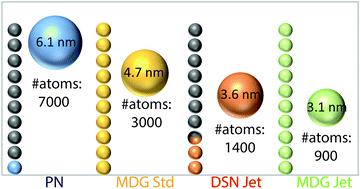当前位置:
X-MOL 学术
›
J. Anal. At. Spectrom.
›
论文详情
Our official English website, www.x-mol.net, welcomes your
feedback! (Note: you will need to create a separate account there.)
Improving detection capability for single particle inductively coupled plasma mass spectrometry with microdroplet sample introduction
Journal of Analytical Atomic Spectrometry ( IF 3.1 ) Pub Date : 2020-11-26 , DOI: 10.1039/d0ja00421a Jovana Kocic 1, 2, 3, 4 , Detlef Günther 1, 2, 3, 4 , Bodo Hattendorf 1, 2, 3, 4
Journal of Analytical Atomic Spectrometry ( IF 3.1 ) Pub Date : 2020-11-26 , DOI: 10.1039/d0ja00421a Jovana Kocic 1, 2, 3, 4 , Detlef Günther 1, 2, 3, 4 , Bodo Hattendorf 1, 2, 3, 4
Affiliation

|
Single particle inductively coupled plasma mass spectrometry (sp-ICPMS) is an attractive technique for fast measurement of elemental composition, mass and particle number concentration (PNC) of metal containing nanoparticles (NPs). In order to investigate NPs <10 nm using ICPMS, low instrumental background and high detection efficiency are primary requirements. This study evaluated the performance of a sector-field ICPMS with standard and enhanced sensitivity (“Jet”) vacuum interfaces with different sample introduction setups: conventional pneumatic nebulization with (DSN) and without aerosol desolvation (PN) and microdroplet generation (MDG). Additionally, the influence of nitrogen gas as an addition to a dry aerosol was studied. In this study, transport efficiencies (TEs) and detection efficiencies (DEs) are determined for the different instrumental setups. Gold NP suspensions were analysed and evaluated for PNC and size. Applying counting statistics, the size limit of detection (LODsize) of gold nanoparticles (Au NPs) was estimated to be 6.1 nm and 4.7 nm for PN and MDG with the standard interface, and 3.6 nm and 3.1 nm for DSN and MDG with the “Jet” interface and nitrogen addition, respectively. Additionally, DEs for various elements were determined. 11 isotopes (27Al, 47Ti, 63Cu, 107Ag, 111Cd, 115In, 133Cs, 140Ce, 193Ir, 197Au, and 238U) were measured at a mass resolving power (MRP) of 300 while an MRP of 4000 was used for 56Fe and 66Zn. DEs obtained for the conventional nebulization system with a spray chamber (PN) were in the range of 10−4 to 10−2 counts per atom (low resolution) and 10−6 to 10−5 counts per atom (medium resolution), while significant improvement in DE was obtained for the MDG setup with the “Jet” interface and nitrogen addition resulting in the range of 10−2 to 10−1 counts per atom (low resolution) and 10−4 to 10−3 counts per atom (medium resolution). The enhancement in DE was most pronounced for isotopes of lower m/z indicating reduced mass discrimination of the “Jet” interface with nitrogen gas added to the sample aerosol. The corresponding LODSIZE could thus be decreased by 10 or 2 times for example for Al- and Au-containing NPs, respectively. At the same time the use of an MDG for sample introduction allowed for 98.5% TE in the analyses of NP suspensions, while a TE of 10% (PN) or 23% (DSN) was obtained with pneumatic nebulizers.
中文翻译:

引入微滴样品提高单颗粒电感耦合等离子体质谱的检测能力
单粒子电感耦合等离子体质谱法(sp-ICPMS)是一种用于快速测量含金属纳米粒子(NPs)的元素组成,质量和粒子数浓度(PNC)的有吸引力的技术。为了使用ICPMS研究<10 nm的NP,低仪器背景和高检测效率是主要要求。这项研究评估了具有标准和增强灵敏度(“ Jet”)真空接口,具有不同样品引入设置的扇形场ICPMS的性能:具有(DSN),不具有气溶胶脱溶剂(PN)和微滴生成(MDG)的常规气动雾化。另外,研究了氮气对干气溶胶的影响。在这个研究中,针对不同的仪器设置确定了运输效率(TE)和检测效率(DE)。分析了金纳米颗粒悬浮液的PNC和大小。应用计数统计,检测大小限制(LOD大小的金纳米颗粒(金纳米粒子)的)被估计为分别为6.1 nm,对于PN和MDG 4.7 nm的标准接口,和3.6 nm,对于DSN和MDG 3.1纳米与“喷射”接口和氮此外,。另外,确定了各种元素的DE。在300的质量分辨力(MRP)下测量了11种同位素( 27 Al, 47 Ti, 63 Cu, 107 Ag, 111 Cd, 115 In, 133 Cs, 140 Ce, 193 Ir, 197 Au和238 U)。对于56 Fe和66使用MRP 4000锌 对于具有雾化室(PN)的常规雾化系统获得的DE的范围是每个原子10 -4到10 -2计数(低分辨率)和每个原子10 -6到10 -5计数(中分辨率),而对于具有“喷射”界面和氮添加的MDG装置,DE的改善显着,导致每个原子10 -2至10 -1计数(低分辨率)和每个原子10 -4至10 -3计数(中分辨率)。较低m / z的同位素中DE的增强最为明显表示将氮气添加到样品气溶胶中后,“喷射”界面的质量分辨力降低。因此,例如对于含Al和Au的NP,相应的LOD SIZE可以分别降低10倍或2倍。同时,在NP悬浮液的分析中,使用MDG引入样品可实现98.5%的TE,而使用气动雾化器可获得10%(PN)或23%(DSN)的TE。
更新日期:2020-12-10
中文翻译:

引入微滴样品提高单颗粒电感耦合等离子体质谱的检测能力
单粒子电感耦合等离子体质谱法(sp-ICPMS)是一种用于快速测量含金属纳米粒子(NPs)的元素组成,质量和粒子数浓度(PNC)的有吸引力的技术。为了使用ICPMS研究<10 nm的NP,低仪器背景和高检测效率是主要要求。这项研究评估了具有标准和增强灵敏度(“ Jet”)真空接口,具有不同样品引入设置的扇形场ICPMS的性能:具有(DSN),不具有气溶胶脱溶剂(PN)和微滴生成(MDG)的常规气动雾化。另外,研究了氮气对干气溶胶的影响。在这个研究中,针对不同的仪器设置确定了运输效率(TE)和检测效率(DE)。分析了金纳米颗粒悬浮液的PNC和大小。应用计数统计,检测大小限制(LOD大小的金纳米颗粒(金纳米粒子)的)被估计为分别为6.1 nm,对于PN和MDG 4.7 nm的标准接口,和3.6 nm,对于DSN和MDG 3.1纳米与“喷射”接口和氮此外,。另外,确定了各种元素的DE。在300的质量分辨力(MRP)下测量了11种同位素( 27 Al, 47 Ti, 63 Cu, 107 Ag, 111 Cd, 115 In, 133 Cs, 140 Ce, 193 Ir, 197 Au和238 U)。对于56 Fe和66使用MRP 4000锌 对于具有雾化室(PN)的常规雾化系统获得的DE的范围是每个原子10 -4到10 -2计数(低分辨率)和每个原子10 -6到10 -5计数(中分辨率),而对于具有“喷射”界面和氮添加的MDG装置,DE的改善显着,导致每个原子10 -2至10 -1计数(低分辨率)和每个原子10 -4至10 -3计数(中分辨率)。较低m / z的同位素中DE的增强最为明显表示将氮气添加到样品气溶胶中后,“喷射”界面的质量分辨力降低。因此,例如对于含Al和Au的NP,相应的LOD SIZE可以分别降低10倍或2倍。同时,在NP悬浮液的分析中,使用MDG引入样品可实现98.5%的TE,而使用气动雾化器可获得10%(PN)或23%(DSN)的TE。











































 京公网安备 11010802027423号
京公网安备 11010802027423号